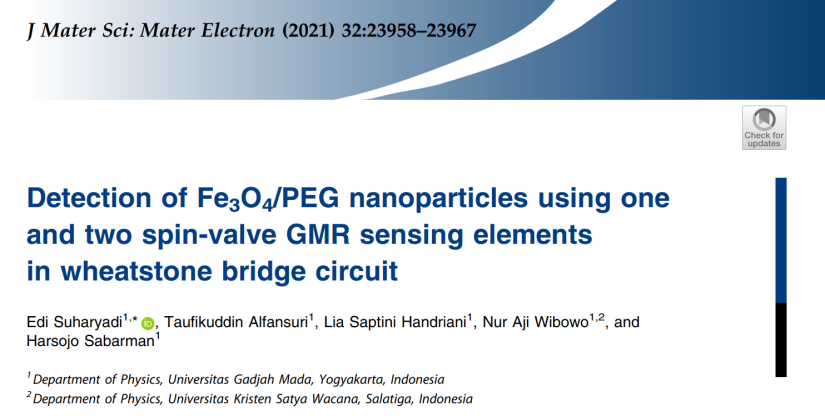
Edi Suharyadi, Taufikuddin Alfansuri, Lia Saptini Handriani, Nur Aji Wibowo, Harsojo Sabarman
https://doi.org/10.1007/s10854-021-06859-6
Journal: Journal of Materials Science: Materials in Electronics
Volume 32, August 2021, 23958–23967
Abstract
Simple Wheatstone bridge-giant magnetoresistance (GMR) sensors with one and two spin-valve (SV) thin films were developed for detecting magnetic nanoparticles (MNPs). SV thin films with a Ta(2 nm)/Ir20Mn80(10 nm)/Co90Fe10(3 nm)/Cu(2.2 nm)/(Co90Fe10)92B8(10 nm)/Ta(5 nm) structure were fabricated using RF magnetron sputtering on Si/SiO2 substrates. Inverse spinel-structured Fe3O4 and Fe3O4/polyethylene glycol (PEG) MNPs were synthesized by coprecipitation methods. To investigate the GMR sensor response, MNPs-ethanol (10 μL) solutions were dropped on the surface of the thin films. The following changes in Fe3O4 were observed after coating with PEG: the size of the nanoparticles increased from 11 to 13 nm, and the saturation magnetization of Fe3O4 decreased from 77.0 to 49.6 emu/g, which can be attributed to the surface modifications by PEG polymer; furthermore, the coercivity increased from 51.2 to 61.5 Oe owing to the existence of the antiferromagnetic phase α-Fe2O3. The output voltage of the GMR sensor with one and two SV thin film elements for Fe3O4 changed by 2.2 and 5.5 mV, respectively, and the output voltage decreased to 1.4 and 1.5 mV, respectively, in the case of Fe3O4/PEG. The decrease in the output voltage was caused by the decrease in the saturation magnetization of Fe3O4 after coating with PEG.
